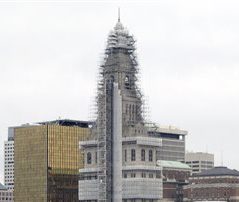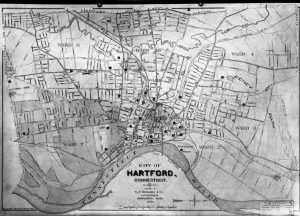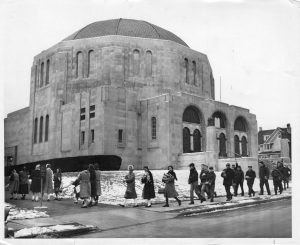The Jewish Community of Hartford, Connecticut (cont.)
By: Jackson Russo
First Steps of the Community
The first legitimate community oriented act by the Jewish people of Hartford was the formation of Beth Israel in 1843. Starting off with only a handful of members meeting within a private home, the Congregation of Beth Israel quickly grew within the city. Only fifteen years after its creation, the congregation grew to nearly 50 members and the group was even able to purchase a former Baptist Church on 400 Main Street to use for their gatherings and worship. The congregation served as the Jewish community’s culture and social center and served as the central hub of activity for anything going on within or involving the community. The Congregation of Beth Israel is still functioning today, with roughly 2,000 members, making one of the two oldest and long-lived Jewish congregations in the state of Connecticut.
By the later years of the 19th century, the Jewish community of Hartford had filled an impressive hole within the infrastructure of the city. That is, to say, members of the community worked in nearly every profession and form of business found in Hartford at this time. Jews filled the roles of butchers, grocers, jewelers, auctioneers, lawyers, boarding house owners, and anything and everything in between. By 1874, Gerson Fox founded the world famous G. Fox & Co Department Store, which remained the largest privately owned department store in the United States until its sale in 1965.
Where Did They Live?
While the Jewish community was methodically forming into a central component of the city of Hartford, most of the members settled in the same general area of the city. According to research conducted by Sandra Becker and Ralph Pearson, members of the Jewish community remained condensed in a small area. Becker and Pearson write that “Most Jewish businesses were located on Main and Front Streets, while most Jews lived in Congress, Buckingham, Governor, and Kilbourn Streets… streets general contiguous with one another in and around downtown Hartford.”
From Community to Local Cornerstone
The Jewish community of Hartford worked together closely to build not only a congregation for their faith, but also a home for their families and futures. However, these strong religious ties that each member of the Jewish faith had with one another did not stop the community from bonding with the city of Hartford as a whole. As early as 1860, members of the Jewish community found their way into the local government, with Alexander Rothschild and Marcus Herlitcheck being elected to the city council. When speaking about the possible disconnect between the Jewish community and the larger, entire Hartford community as a whole, writer and conservative Rabbi Morris Silverman writes that “Far from being a separate people these early Jewish immigrants… were soon contributing to the general life of Hartford.”
The Jewish community of Hartford participated in nearly every field of work, career, or profession available to the city’s citizens and helped jump start the process that would allow the city to grow as a whole. The city seemed to be grateful for this fact during this time as well. By 1875, when the Congregation of Beth Israel held a ceremony and celebration for the opening of a new synagogue in the city, nearly 12,000 members of the city, including Mayor Sprague, attended. The Jewish community had become established as a cornerstone for the city of Hartford and an integral part of the city’s infrastructure and culture.


